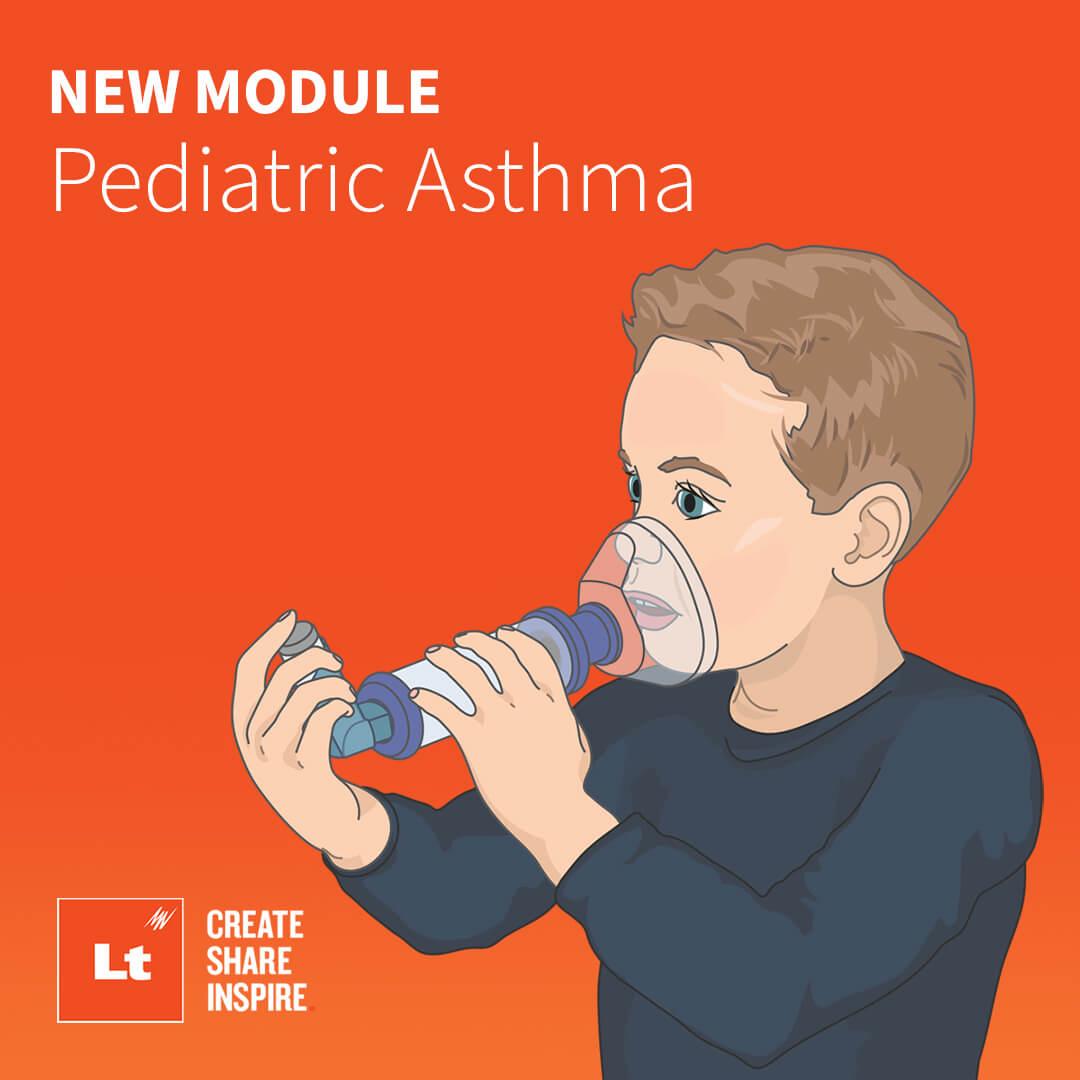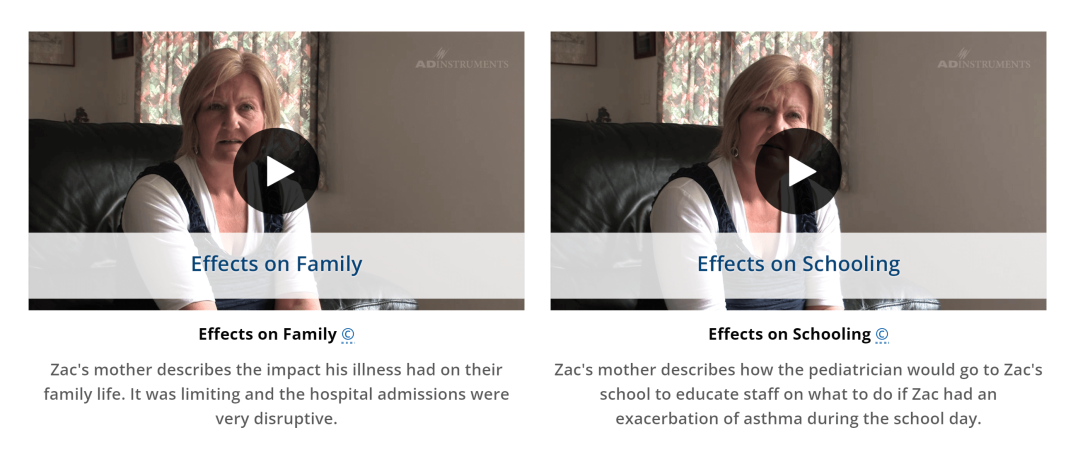Dr. Andrew O’Malley discusses the importance of clinical cases to nursing education and shares how to use our new pediatric asthma case study to teach your nursing students about childhood asthma.

Dr Andrew O'Malley
Case study examples are important in nursing education because they allow students to develop soft skills and apply what they’ve learned in simulated scenarios.
We spoke to Dr. Andrew O’Malley of the University of St Andrews about the new Pediatric Asthma Module he has developed in Lt, which aims to expose students to the experience, symptoms, and pathophysiology of a real case of childhood asthma.
Here, Andrew breaks down the module and shares how you can use it immediately in your course (or edit it as you see fit!).
“...the real texture in these nursing case studies [is] thinking about a distressed parent, an anxious parent. Thinking about a child who is worried that he won't get to play football with his friends. And so actually, we were actually trying to build in much more of a communication skills angle.”
Introducing nursing students to pediatric asthma
The Pediatric Asthma Module shares a real patient case with students: Zac Thayer’s experience of asthma and how it progressed throughout his childhood. It consists of 4 parts.
- Students relate theory to practice as they complete the Airflow Lab.
- In the pediatric asthma video Case Study, students meet Zac and his family, discover Zac’s relevant family history related to asthma, explore his tests, and learn about pediatric asthma treatment and his discharge from hospital.

- In the Scenario, students are asked to perform various roles to educate Zac and his parents about his condition after his asthma diagnosis before he is discharged from hospital.
- In the Evaluation, students summarize the module by answering questions about lung anatomy, physiology of ventilation, and pediatric asthma and its management.
Preview the Pediatric Asthma Case Study »
Each of the parts of the module are fully-editable, meaning that you can pick and choose content based on your students’ level of experience and the time constraints you are working under. Learning outcomes are provided, and can be edited according to the nursing standards in your region.
“The immersive nursing module is split into a couple of different lessons, and educators can choose what they do with it; it doesn't have to be an off-the-shelf product that you use and don't alter.”
How to use the Airflow Lab
The Airflow Lab lets students get hands-on with pulmonary function tests. By the end of the session, students will know how to:
- perform these tests
- measure and analyze pulmonary function variables like FEV1
- appreciate how it feels to breathe with constricted airways, such as in asthma, and
- compare pulmonary function variables between ‘normal’ data and ‘simulated asthma’ data.
For nursing students, who may lack a technical science background, this opportunity to get in the lab and measure pulmonary variables using a spirometer lets them link theory to practice without the added stress of dealing with a real or simulated patient.
Students are able to become more comfortable using complex equipment and working together in teams when collecting data from each other.

They also develop relevant clinical experience in using a handheld peak flow meter. Peak flow meters are widely used in clinical contexts to gauge respiratory health, and also to monitor treatment efficacy in asthma patients.
By combining this standalone lab with a relevant case study on childhood asthma, students can synthesize their learnings and understand how the mechanics and pathophysiology of asthma relates to the outcomes that they see in the case. As Andrew says:
“That's the point of medical cases, is that they give them something to hang the [theoretical] knowledge off.”
How to use the Case Study
Adding a relevant clinical case study to your curriculum means students can understand the ripple effect that a disease has throughout a family. In the case of pediatric asthma, nurses will be dealing not only with the affected child, but also with their caregivers, who may be stressed, worried, or upset. This is a valuable insight:
“The students are coming in from school often, they're really young. Their life experience is limited, which is just a function of their age. So unless they've really had a personal experience of a particular illness through their family, these nursing case study examples will give them a real insight into how certain disease processes affect a family. And I think that's often really hard to capture in a textbook or a lecture.”

Pediatric simulation scenarios make it easier for students to learn. By ‘meeting’ Zac Thayer and his real presentation of pediatric asthma, students discover his asthma history timeline and watch videos of him, his parents, and his healthcare providers, including a Respiratory Nurse Specialist. Students can answer interactive questions as they move through this respiratory case study, making sure that they reflect and record their learnings about asthma in children.

“There's lots of interactives in there for the students to get personalized, instant feedback as they go through.”
Linking back to the Airflow Lab, students explore typical peak flow test results for an asthmatic child like Zac. If you’ve chosen to provide students with the lab first, then this step lets them situate their theoretical knowledge within a real case.
Providing each student with the same medical case also improves equitable access; students will see different patients in practice, but this is an opportunity for them to learn and question the same case, in a safe space.

Students are also encouraged to think about trends within the data they are seeing, and to consider what external factors might be at play to influence the peak flow values they observe. In this pediatric asthma case, this might be pollen in the air outdoors, indoor air pollution during winter, or more dust mites during autumn.
When a young child like Zac is admitted to the hospital, part of a nurse's role is to monitor them for signs of respiratory distress. Additionally, nurses must be able to describe these warning signs to parents and caregivers to help them identify signs of respiratory distress once the child has been discharged from the hospital. Thus, we’ve made sure that students learn about common signs of respiratory distress in this case study, including:
- cyanosis
- pallor
- respiratory accessory muscle use
- respiratory retractions
- tachypnea
- bradypnea
Finally, students learn about discharging the patient, including patient education (discussing certain topics with the patient and their caregivers before they leave the hospital). In the case of pediatric asthma, students might discuss:
- how to reduce asthma triggers
- how to use inhalers, spacers, and nebulizers properly
- how to keep a peak flow diary, and
- how to develop an Asthma Action Plan.
“...when we get to the end of the case, the safe discharge or the observation of the patient is actually about, “Well, how do you use your asthma inhaler? What do you do if you begin to feel you're having an asthma attack? How do you know if your asthma is getting worse? How are we going to stop you from having an attack next time?” But it's not, “I'm going to prescribe you X milligrams of salbutamol, and we'll up it in 3 days,” - that's the doctor's job.”
How to use the Scenario
In the asthma case Scenario, students are able to practice their nursing skills in a ward-like setting. This lesson is a guide during a simulated clinical experience under educator supervision.
“And then we've got the Patient Education section, which actually is as important as the story. It focuses on the knowledge and understanding and skills that the patient needs to have with them that will allow them to be safe and to manage their condition. So for this asthma case it might be being safe while going to school, or playing with your friends.”
Students take on a variety of roles in this simulation, including:
- Registered nurse: The student needs to explain what it means for Zac to have asthma and how the two types of medication provided work to alleviate and prevent symptoms. The student also completes an Asthma Action Plan alongside the parents, and explains what needs to happen in each instance of Zac's condition worsening. It is important to correctly assess how much the parents comprehend.
- Student nurse: The student needs to teach Zac's parents how to help Zac correctly complete a peak flow meter test, and show them how to record the results in a peak flow diary. The student should explain how certain triggers might make his asthma worse, which can explain the fluctuations in peak from day-to-day and season-to-season. It is important to correctly assess how much the parents comprehend.
- Zac's parents: The student acts as a parent, who is very worried about future asthma attacks for Zac. They are unsure when it is appropriate to stay at home, or when to call an ambulance. They are emotionally and mentally exhausted after Zac's hospital stay and very eager to return home for a family meal. Their attention span feels limited after the stress of the past few days.
This scenario builds empathy in the students as they learn how to interact with Zac’s parents, and act as the parents themselves. Patient scenario examples help to build this important skill for nurses, who will be working in stressful environments, and with people who may have heightened emotions.
“It really ties together the basic anatomy, physiology, pathology, pharmacology, all the basic science, with the real outcome that the patient wants, for them to go out and enjoy their time.”
How to use the Evaluation
The Evaluation lesson is intended to be used at the end of the module, and tests essential student knowledge. Depending on your course aims, this could be a summative assessment, or you could choose to assign it to students as a formative assessment to work through in their own time.
“There's a bit of storytelling, a lot of patient safety, a lot of nurse management and then, from the student perspective, it really, clearly signals to the student whether they've understood what they're working with. We've tried to avoid big blocks of text and didactic heavy reading.”

If you do choose to use the Evaluation in your course, the ready-made feedback supports students to take control of their own learning, which is an important skill to learn in a case-based curriculum.
“The inherent ability to create interactive, immediate feedback within Lt is really good. So most of it actually isn't us teaching the students about this thing, it's the student watching a video, reflecting on it, making some notes, answering a question, getting good feedback.”
Conclusion
We recommend that you try to tie your theoretical lectures and labs as closely as possible to clinical cases in your nursing course curriculum.
Rather than a traditional curriculum, which might expose students to the physiology of breathing in year 1, pediatric asthma pathophysiology in year 2, and patient interactions in year 3, a blended curriculum means that students can apply their theoretical knowledge immediately, and appreciate the relevance of what they are learning for their future careers.
In Andrew’s teaching, each week of his course starts with a case, which kicks off a week of theoretical and clinically-situated learning. Each week is a “mini medical degree” and students appreciate the fact that their learning is integrated.
“Cases are a trigger for learning at the beginning of the week. It inspires the student to connect with the content. Giving a student a real experience with a real patient with asthma means that all that learning they've done about bronchodilation and smooth muscle receptors is extremely relevant, and it makes it much more likely that they'll retain that information.”
Providing your nursing students with relevant case studies has many benefits. Students develop an appreciation for the complex factors at play within families, how conditions are treated, what to look for when observing patients in the hospital, and how to approach patient education.
By starting with a ready-made Case Module, you can provide these benefits to your students while saving time - and their editable nature means that your cases will always be relevant. You can also branch out by pulling from our 30+ Patient Resource Packs on a range of relevant medical conditions.
“It's all about relevance. The more your content aligns with other content, it’s a compound effect, they all become much more valuable.”
Preview the Pediatric Asthma Case Study »
Contact us to learn more about the Immersive Nursing Collection in Lt »

Dr. Andrew O'Malley
Dr. Andrew O’Malley
Senior Lecturer
School of Medicine
University of St Andrews
Andrew graduated with a PhD in Anatomy & Human Identification from the University of Dundee in 2013. He has worked as a Forensic Consultant with the United Nations and has a particular interest in medical education.
He is currently the ScotGEM Deputy Program Director at the University of St Andrews. ScotGEM is a unique 4-year program that develops doctors for rural practice in Scotland.
